News & Updates 2015
23 December
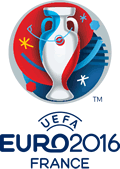 I apologise for the lack of activity this month, which was due to a computer malfunction. We're now up and running again and I'm delighted to launch our much anticipated Euro 2016 section. Please be advised that under the terms of their eight-year ban from football activity, Herr Blatter and M Platini are not allowed on the premises.
I apologise for the lack of activity this month, which was due to a computer malfunction. We're now up and running again and I'm delighted to launch our much anticipated Euro 2016 section. Please be advised that under the terms of their eight-year ban from football activity, Herr Blatter and M Platini are not allowed on the premises.
4 December - Early Manchester United Change Kits
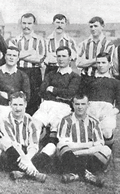 I've been reviewing the information we have about Manchester United's change kits between 1902 and 1921 with Paul Nagel, Tim Ashmore (unitedkits.com) and Daniel Gellatley. This follows Daniel's discovery that United wore green and white at Bristol City in September 1902 (see 11 November). Several more contemporary references have been discovered that refer to United's change colours as green and white. Significantly, Paul has found no references to blue although the club's official
I've been reviewing the information we have about Manchester United's change kits between 1902 and 1921 with Paul Nagel, Tim Ashmore (unitedkits.com) and Daniel Gellatley. This follows Daniel's discovery that United wore green and white at Bristol City in September 1902 (see 11 November). Several more contemporary references have been discovered that refer to United's change colours as green and white. Significantly, Paul has found no references to blue although the club's official 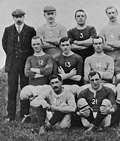 position is that this was their alternative colour at the time. Our conclusion is that United's change tops for most of this period were in fact green and white stripes.
position is that this was their alternative colour at the time. Our conclusion is that United's change tops for most of this period were in fact green and white stripes.
White shirts were used between 1905 and 1910 but I have re-examined this squad photograph (right) from 1907-08 in which half of the players are in pale alternative tops. Given  what we now know about film stock at the time being more sensitive to blue light than other colours, I am confident that these are indeed blue tops. (The shade matches the band on the sock turnover and we know this was blue.) This resolves the mystery of the shirt on display in the United Museum (left) believed to date from between 1900 and 1912.
what we now know about film stock at the time being more sensitive to blue light than other colours, I am confident that these are indeed blue tops. (The shade matches the band on the sock turnover and we know this was blue.) This resolves the mystery of the shirt on display in the United Museum (left) believed to date from between 1900 and 1912.
You can review Tim Ashmore's collection of team photographs on Flickr.
2 December
Scottish Club Updates for 2002-03: Dunfermline Athletic, Livingston, Dundee, Aberdeen, Heart of Midlothian, Partick Thistle, Rangers.
1 December
The Bad News - Campo Retro have closed their online store and their limited but useful range of replica shirts is no longer available. I have removed links to their products and taken the opportunity to remove many other redundant links as well.
The Good News - I am very pleased that we are now linked into the Classic Football Shirts store and you will find deep links throughout the English and Scottish club sections that allow you to browse their extensive collection of genuine replica and match worn shirts directly from HFK.
24 November
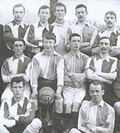 I was recently contacted by Paul Farley, a Director of Exeter City FC, on behalf of The Grecian Archive. This comprehensive site, set up by Exeter University and the Exeter City FC History Group, contains an enormous collection of memorabilia, photohgraphs, programmes etc and brings together material from various personal collections, the Supporters' Trust and club archives. Thanks to the large library of team photographs I have been able to complete a comprehensive update of the Exeter City section with many gaps now filled. The featured photograph is of the first Grecians team from 1904-05, when the team wore green and white.
I was recently contacted by Paul Farley, a Director of Exeter City FC, on behalf of The Grecian Archive. This comprehensive site, set up by Exeter University and the Exeter City FC History Group, contains an enormous collection of memorabilia, photohgraphs, programmes etc and brings together material from various personal collections, the Supporters' Trust and club archives. Thanks to the large library of team photographs I have been able to complete a comprehensive update of the Exeter City section with many gaps now filled. The featured photograph is of the first Grecians team from 1904-05, when the team wore green and white.
23 November
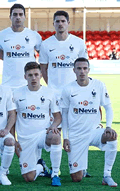 Hamilton Academical wore the French national team's change strip at Aberdeen over the weekend as a tribute to the victims of the recent terrorist attacks in Paris, a fine gesture that has been greeted by widespread approval. The shirts are now on their way to French Ligue 1 clubs to be auctioned off in support of their favoured charities.
Hamilton Academical wore the French national team's change strip at Aberdeen over the weekend as a tribute to the victims of the recent terrorist attacks in Paris, a fine gesture that has been greeted by widespread approval. The shirts are now on their way to French Ligue 1 clubs to be auctioned off in support of their favoured charities.
Hartlepool United's latest FA Cup strip has been added.
Scotland's new kits have also been added.
20 November
Let me introduce you to what will be known to posterity as Moor's Law. This states that when two possibilities are equally likely, the one I choose will be wrong. It goes on to state that if, being aware of this, I change my mind and choose the other possibility, my first choice will have been the correct one. And so on.
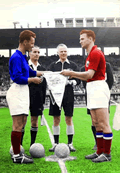 To illustrate, when Yugoslavia met France in the 1954 World Cup, one team had to change. I assumed, in the absence of any other evidence, it was France.
To illustrate, when Yugoslavia met France in the 1954 World Cup, one team had to change. I assumed, in the absence of any other evidence, it was France.
Wrong!
This colourised photograph, submitted by José Luis 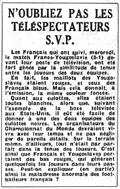 Carbonell suggests that the Yugoslav team switched to red shirts. Now I don't normally trust colourised images but José thoughtfully submitted several contemporary press reports which, once translated by our resident elves, corroborate the image.
Carbonell suggests that the Yugoslav team switched to red shirts. Now I don't normally trust colourised images but José thoughtfully submitted several contemporary press reports which, once translated by our resident elves, corroborate the image.
Incidentally, this cutting from a French newspaper complains that the teams were impossible to tell apart on the primitive TVs of the time and suggests that in future, when both 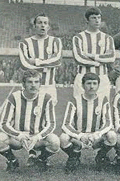 teams wear white shorts one should change into black ones, following the example set in the United States. FIFA eventually heeded
teams wear white shorts one should change into black ones, following the example set in the United States. FIFA eventually heeded 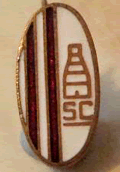 this advice in 1962 and has since taken this idea to ludicrous limits with its insistence on high levels of contrast.
this advice in 1962 and has since taken this idea to ludicrous limits with its insistence on high levels of contrast.
Almost a year ago I published this photograph of the Stoke City team in December 1968 wearing what was described as a "kiln badge" designed by David Herd. Details of this crest appeared to have been lost but now Keith MacKenzie-Ingle has submitted this enamel badge from the period from which I have been able to reconstruct the original.
18 November
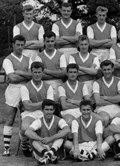 New kits: Northern Ireland (change), Brighton & Hove Albion (special), York City (3rd).
New kits: Northern Ireland (change), Brighton & Hove Albion (special), York City (3rd).
Thanks to Dick Waite I have been able to revise the Arsenal section 1957-60 and add some unrecorded change kits for the same period. This is the 1959-60 squad.
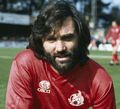 Late in the 1982-83 season George Best joined AFC Bournemouth at the age of 37. Rutger Karssing spotted that the crest worn at the time was missing from HFK, an omission now put right.
Late in the 1982-83 season George Best joined AFC Bournemouth at the age of 37. Rutger Karssing spotted that the crest worn at the time was missing from HFK, an omission now put right.
Southampton (1965-66 warm weather kit added): Leeds United (2014-15 3rd kit revised): Huddersfield Town (1989-91 manufacturer corrected).
14 November
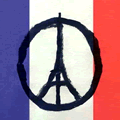
Liberté, égalité, fraternité
Solidarité
13 November
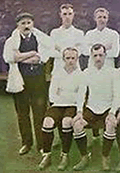 This is a rare colourised photograph of Port Glasgow Athletic from 1909 discovered by Brian McColl. Sources differ about the colour of the team's knickers but the most convincing evidence, derived from SFA and SFL records, gives them as white and navy so I believe the colours added to this image are incorrect. Incidentally, the HFK family was once based on Port Glasgow a few hundred metres from Devol Farm, where the team, then known as Broadfield, played in their first ever season.
This is a rare colourised photograph of Port Glasgow Athletic from 1909 discovered by Brian McColl. Sources differ about the colour of the team's knickers but the most convincing evidence, derived from SFA and SFL records, gives them as white and navy so I believe the colours added to this image are incorrect. Incidentally, the HFK family was once based on Port Glasgow a few hundred metres from Devol Farm, where the team, then known as Broadfield, played in their first ever season.
Tottenham Hotspur (2006-07 European kit added).
11 November - International Updates
Wales wore red and blue "quartered" shirts against England in 1894 and Scotland in 1895. Their new change kit has been added.
Republic of Ireland kit v Northern Ireland in 1978 tweaked.
1982 World Cup: Honduras wore a variant of their usual Adidas shirts against Yugoslavia.
Historical Club Updates
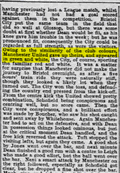 An important find by Daniel Gellatly in the Western Daily Press (22 Sept 1902) reveals that Manchester United wore green and white when they visited Bristol City at the start of the 1902-03 season. I think it likely that these were old Newton Heath tops drafted in before their new blue and white alternative shirts arrived.
An important find by Daniel Gellatly in the Western Daily Press (22 Sept 1902) reveals that Manchester United wore green and white when they visited Bristol City at the start of the 1902-03 season. I think it likely that these were old Newton Heath tops drafted in before their new blue and white alternative shirts arrived.
Clyde (1978-79 centenary kit added).
10 November
Latest third kits: Brentford, Dunfermline Athletic.
Euro 16: The first new strips for next year's bloated European Championship are being released, including new outfits for Northern Ireland and Wales. HFK will be launching our new Euro 16 section after the draw for the finals is made next month.
30 October - To the people of Birmingham and Wolverhampton, an apology
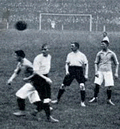 I've been taken to task by Alan Watton for describing Birmingham and Wolverhampton Wanderers as "Black Country Rivals" (see item 26 August). Alan writes, " Birmingham is not part of the Black Country and never has been. This error is a grave insult to both parties and animosity felt between Birmingham and its "Yam Yam" neighbours was even more intense in the period of your photo."
I've been taken to task by Alan Watton for describing Birmingham and Wolverhampton Wanderers as "Black Country Rivals" (see item 26 August). Alan writes, " Birmingham is not part of the Black Country and never has been. This error is a grave insult to both parties and animosity felt between Birmingham and its "Yam Yam" neighbours was even more intense in the period of your photo."
I apologise unreservedly to the good citizens of both cities. The unfortunate intern responsible for this slur is undergoing a period of intensive retraining following which he will deliver personal apologies to every household affected. And I leave you with this:
Brummie walks into a tailors shop...
"Alroit mate, I'd like a 70s suit please."
The tailor says, "Certainly sir and would you like a kipper tie?"
"Thanks mate, two sugars please."
28 October - More Third Kits
Millwall, Crawley Town, Cambridge United, Tottenham Hotspur (Europa 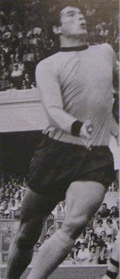 League kit).
League kit).
We have more on the gold and black kit (left) worn by Liverpool at Arsenal in August 1967 (see 15 October entry). The Reds lost the match 2-0 with Tony Hateley scoring an own goal. According to Graham Brack, Liverpool's legendary manager, Bill Shankly, blamed the novel gold shirts for the team's bad luck and had them burned. It would be 11 years before they would be seen in yellow once again.
International Updates
Euro 84: Romania's yellow strip was trimmed in blue 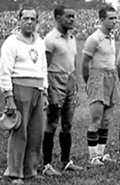 and not red/yellow/blue.
and not red/yellow/blue.
World Cup 1934: Czechoslovakia probably wore dark red shorts rather than black against Romania.
World Cup 1938: Brazil's training shirts worn against Poland had short sleeves (right).
26 October - New Third Kits
22 October
After reading the items on Stoke City's candy stripe shirt, historian Tony Sealey looked out the programme for the Tottenham Hotspur v Stoke City match mentioned yesterday and found this:
Stoke expect to play in their new and somewhat unfamiliar light-weight strip this evening. This consists of a predominantly red shirt with a thin white stripe, which retains the clubs traditional colours yet makes marked contrast with the wider 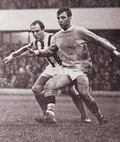 red and white stripes identified with Stoke teams for so many years. The old strip has not been discarded. In cold weather of mid-winter the thicker and more familiar looking broad striped shirt is likely to be introduced.
red and white stripes identified with Stoke teams for so many years. The old strip has not been discarded. In cold weather of mid-winter the thicker and more familiar looking broad striped shirt is likely to be introduced.
Tony confirms that the novel tops were worn in the return match a week later. I have found two photographs that 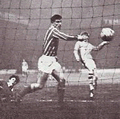 appear to confirm this story: above left Stoke are playing Manchester City on 12 November 1966 in their normal strips while in the return, played at Maine Road on 12 April 1967, the Potters are in their alternative tops.
appear to confirm this story: above left Stoke are playing Manchester City on 12 November 1966 in their normal strips while in the return, played at Maine Road on 12 April 1967, the Potters are in their alternative tops.
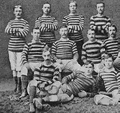 Tony goes on to tell us that the shirt illustrated on 15October was sent to a young fan by Stoke's manager, Tony Waddington. It had no number on the reverse so was not match worn.
Tony goes on to tell us that the shirt illustrated on 15October was sent to a young fan by Stoke's manager, Tony Waddington. It had no number on the reverse so was not match worn.
Before I leave this topic, I thought you would enjoy a look at this Stoke team photograph from 1877-78, when the team wore light blue and black hoops of varying widths.
International Updates
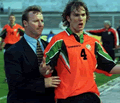 This is Jason McAteer of the Republic of Ireland failing to understand why the referee has invited him to leave the pitch against Macedonia in April 1997. The answer to this puzzle is here. (Warning - contains gratuitous kung fu.)
This is Jason McAteer of the Republic of Ireland failing to understand why the referee has invited him to leave the pitch against Macedonia in April 1997. The answer to this puzzle is here. (Warning - contains gratuitous kung fu.)
Scotland 1882 crest confirmed.
World Cup 1934: Switzerland (collar corrected).
World Cup 1938: Hungary and the Dutch East Indies wore long, not short sleeved shirts as shown previously, while Germany's team wore short sleeves.
Euro 1980: Spain (collars corrected).
World Cup 1982: Czechoslovakia wore pinstriped shirts against France.
World Cup 1994: Greece (collar detailing added), Argentina (crest and shorts modified), Norway (shorts detailing modified).
World Cup 2010: Switzerland (1st kit collar corrected), Paraguay (detailing added to socks).
21 October
The first game that David Cohen attended at the tender age of ten was Tottenham Hotspur against Stoke City in August 1966 and he vividly remembers the visitors wore the candy striped shirts featured below. This suggests I was wrong to identify this as a cold weather shirt and a bit of further digging turned up the same tops being worn at Manchester City later in the season so I now believe this was used when Stoke visited teams wearing pale shirts.
New Third Strips
Mansfield Town, Rochdale, Newport County.
Historical Updates
St Johnstone, Ross County, Dundee, Motherwell, (2001-02 detailing modified): Airdrie (March-August 2013 added): Chelsea (several first kit graphics 1945-46, 1959-68, 1984-86 tweaked; 1945-46 change added): Bristol Rovers (2005-06 modified).
15 October
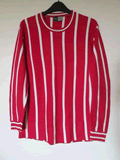 I'm grateful to long-time contributor, William Kay, who found several images of Stoke City's cold weather kit from 1966-67, which substituted fashionable candy stripes for the traditional style. Willie has also alerted me to the fact that Airdrieonians have finally taken delivery of their new Macron strips.
I'm grateful to long-time contributor, William Kay, who found several images of Stoke City's cold weather kit from 1966-67, which substituted fashionable candy stripes for the traditional style. Willie has also alerted me to the fact that Airdrieonians have finally taken delivery of their new Macron strips.
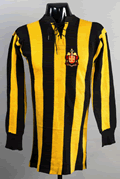 This is the shirt worn by Tancy Lea for Wolverhampton Wanderers in the 1921 FA Cup final, sold at Sotheby's in May for £6700. These were made specially for the final but became plastered in mud because of the state of the pitch so the Wolves team changed for the second half into their regular shirts, which had broader stripes and no crest. (Submitted by Tony Sealey.)
This is the shirt worn by Tancy Lea for Wolverhampton Wanderers in the 1921 FA Cup final, sold at Sotheby's in May for £6700. These were made specially for the final but became plastered in mud because of the state of the pitch so the Wolves team changed for the second half into their regular shirts, which had broader stripes and no crest. (Submitted by Tony Sealey.)
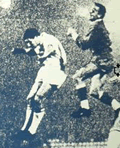 This grainy photograph is from November 1964 and shows Liverpool in action against Anderlecht. This was the first time that Liverpool turned out in all-red. It was Bill Shankly's idea to wear red shorts rather than their usual white ones and according to Ian St John's autobiography, he (St John) suggested adding all-red socks as well. In fact these were not adopted until March 1965. Liverpool won the FA Cup two months later in all-red and have never looked back. Read the full story here in the Liverpool Echo. (Submitted by Tony Sealey.)
This grainy photograph is from November 1964 and shows Liverpool in action against Anderlecht. This was the first time that Liverpool turned out in all-red. It was Bill Shankly's idea to wear red shorts rather than their usual white ones and according to Ian St John's autobiography, he (St John) suggested adding all-red socks as well. In fact these were not adopted until March 1965. Liverpool won the FA Cup two months later in all-red and have never looked back. Read the full story here in the Liverpool Echo. (Submitted by Tony Sealey.)
Still with Liverpool, the team wore an unfamiliar yellow and black strip at Highbury in August 1967.
Simon Knifton has confirmed that the white strip worn by Wimbledon (the original club) in 1976-77 was used only in cup games. They wore the all-yellow kit trimmed with blue adopted in 1975 in the Southern League. Of course, when they were elected to the Football League in 1977, they wore all-white in their inaugural season.
13 October
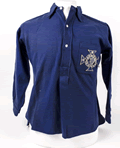 Our good friend Tim Ashmore has been working at the National Football Museum over the last 12 months and has
Our good friend Tim Ashmore has been working at the National Football Museum over the last 12 months and has 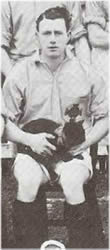 uncovered this shirt worn by Andrew Gara who played for Ireland in the 1902 Home Championship. (Photograph courtesy of The National Football Museum.) The significant point here is that this confirms that the shade of "St Patrick's Blue" worn by the Irish team was a deep shade and not the pale blue I previously believed. This misinterpretation was due once again to the peculiarities of the orthographic film stock widely used at the time. This photograph (right) from 1914, illustrates how early Irish teams appear when photographed with film that was highly sensitive to blue light.
uncovered this shirt worn by Andrew Gara who played for Ireland in the 1902 Home Championship. (Photograph courtesy of The National Football Museum.) The significant point here is that this confirms that the shade of "St Patrick's Blue" worn by the Irish team was a deep shade and not the pale blue I previously believed. This misinterpretation was due once again to the peculiarities of the orthographic film stock widely used at the time. This photograph (right) from 1914, illustrates how early Irish teams appear when photographed with film that was highly sensitive to blue light.
You can also see the effect quite clearly on this photograph of the 1927 FA Cup final, in which Hughie Ferguson's Cardiff City shirt appearsto be a good deal lighter than those of Arsenal. In fact they were a standard royal blue as can be seen in this photograph of LenDavies' shirt from the same match, which was sold at Sotheby's in May.
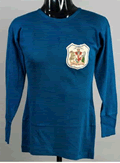 (Photographs courtesy of WalesOnline.)
(Photographs courtesy of WalesOnline.)
9 October - Latest Commemorative & Special Kits Added
Premier League: Southampton, Liverpool.
Championship: Huddersfield Town, Bolton Wanderers, Sheffield Wednesday (3rd).
SPFL Premier League: Celtic, Dundee.
MLS: Seattle Sounders (3rd kit new sponsor).
Ciaran McNulty has produced a video to illustrate the changing look of Liverpool derbies using HFK graphics which might amuse you. View it here on YouTube.
23 September - More Historical Scottish Updates
Ian McConnel has been through his collection of SPL programmes and provided information that allows me to correct some fine details on graphics from the 2001-02 season: Dundee United, Dunfermline Athletic, Heart of Midlothian, Aberdeen, Rangers (change).
22 September
I was very pleased to hear from Alick Milne once again. Alick made a major contribution to the Scottish club section when this was under construction. He has now resumed his research in the Scottish National Library and has shared his latest findings with us.
Stranraer (1985-87, 1987-88), Brechin City (1985-88), Ayr United (1987-88), Dumbarton (1985-86, 1986-87), Meadowbank Thistle (1985-86, 1986-87) have all been revised to the Umbro Roma design from 1985.
Annan Athletic (1970-72 added and the missing kits between 1998 and 2004 has now been documented): Gretna (2000-01, 2001-02 added; 1998-99, 2002-03, 2003-04 amended).
21 September - 2015-16 Update
Premier League: Manchester City (3rd added).
Championship: Ipswich Town (3rd revised), Cardiff City (3rd added), Nottingham Forest (shirt sponsor added), Derby County (3rd added).
League One: Colchester United (3rd added).
League Two: Stevenage (1st socks updated), Northampton Town (3rd updated).
SPFL Premier League: Heart of Midlothian (3rd added).
11 September
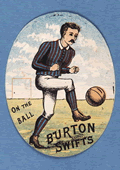 I normally do not set much store by old cigarette cards (or
I normally do not set much store by old cigarette cards (or 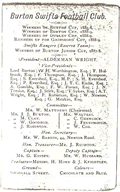 "silks" as they were known in the Victorian period) but this image of Burton Swifts' colours is corroborated by the document on the right, published in 1888-89. This provides the first evidence of what the team (perversely known as "The Swallows") wore before they were elected to the Football League in 1892. Both items can be found on the greyhoundderby.com website.
"silks" as they were known in the Victorian period) but this image of Burton Swifts' colours is corroborated by the document on the right, published in 1888-89. This provides the first evidence of what the team (perversely known as "The Swallows") wore before they were elected to the Football League in 1892. Both items can be found on the greyhoundderby.com website.
Going even further back in time, I recently came across this rare image of Forest FC (later The Wanderers) from October 1863, which makes this one of the earliest ever team photographs. 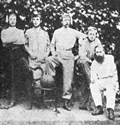 There were no kits as we understand the term at this time: most games were organised within the club and players wore whatever they had to hand. Most of the gentlemen players here are wearing what appear to be cricket whites which is hardly surprising as they would certainly have played the summer game, organising the football team to keep fit and socialise during the close season. Three of the players, however, are wearing shirts with very narrow vertical stripes: these are associated with Harrow School where several of the founders, including the Alcock brothers, finished their education.
There were no kits as we understand the term at this time: most games were organised within the club and players wore whatever they had to hand. Most of the gentlemen players here are wearing what appear to be cricket whites which is hardly surprising as they would certainly have played the summer game, organising the football team to keep fit and socialise during the close season. Three of the players, however, are wearing shirts with very narrow vertical stripes: these are associated with Harrow School where several of the founders, including the Alcock brothers, finished their education.
1 September - Hull City 1904-05
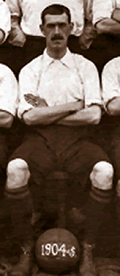 Once again I'm pleased to present some more clever detective work, this time by Nicholas Turner. It has long been believed that Hull City started out wearing white shirts, an assertion based on two contemporary team photographs. Nicholas has proved that one of these is from a benefit game that did not involve the Tigers at all and established that the second image, shown on the left was taken before a match with Bradford City. A press report
Once again I'm pleased to present some more clever detective work, this time by Nicholas Turner. It has long been believed that Hull City started out wearing white shirts, an assertion based on two contemporary team photographs. Nicholas has proved that one of these is from a benefit game that did not involve the Tigers at all and established that the second image, shown on the left was taken before a match with Bradford City. A press report 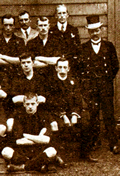 confirms that "City turned out in white shirts the Bradford shirts being very similar in (sic) those of the home team."
confirms that "City turned out in white shirts the Bradford shirts being very similar in (sic) those of the home team."
In fact, the Hull Daily Mail, announcing the formation of the team (24 August 1904) reported, "The Hull City team, we are informed, have decided to play in amber and black vertically striped shirts." A team photograph (right) taken before their first ever game against Notts County is not terriblyhelpful but a wonderful clip from the British Film Institute shows clearly that the Citizens (as they were then known) did indeed wear stripes. We should not be surprised that the 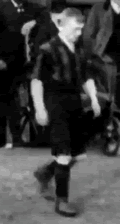 team photograph fails to reveal this detail given what we now know about some of the film stock in use at the time (see item on Wolves 26 August below).
team photograph fails to reveal this detail given what we now know about some of the film stock in use at the time (see item on Wolves 26 August below).
You can read the full article on the Hull City Kits website.
More Historical Updates
A rare team 1896-97 photograph of Liverpool published on the Unofficial Liverpool FC Museum's Facebook page shows the team wearing black knickers but press reports on their first match of that season state they wore white "pants." The kit looks pristine in the photograph so presumably it was taken pre-season and the knickers subsequently changed from black to white.
Newcastle United (1930-31 socks confirmed): Northampton Town (1991-92 crest modified, 1997-98 centenary crest added): Sheffield Wednesday (1977-84 detailing updated).
28 August - 2015-16 Update
Premier League: Manchester United (3rd).
Championship: Blackburn Rovers (2nd shirt sponsorship updated), Brighton & Hove Albion (1st 2nd 3rd detailing corrected).
League Two: Exeter City (2nd socks updated), Yeovil Town (1st socks updated).
SPFL Championship: St Mirren (2nd). This completes the SPFL section.
27 August - Luton Town Early Years
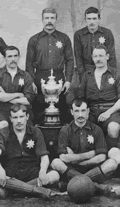 Anyone with an interest in Luton Town will enjoy Brian Webb's The Straw Plaiters website. Brian has done extensive research into the club minute books and local press reports covering the period from their formation in 1885 through to 1894 and the results make absorbing reading. In particular Brian has uncovered very detailed evidence of Luton's earliest colours. His latest post is an interesting discussion of the possible meaning behind the unusual eight-pointed star worn on the team's shirts between 1892 and 1896 (left).
Anyone with an interest in Luton Town will enjoy Brian Webb's The Straw Plaiters website. Brian has done extensive research into the club minute books and local press reports covering the period from their formation in 1885 through to 1894 and the results make absorbing reading. In particular Brian has uncovered very detailed evidence of Luton's earliest colours. His latest post is an interesting discussion of the possible meaning behind the unusual eight-pointed star worn on the team's shirts between 1892 and 1896 (left).
With information provided by Matthew Reynolds I have also updated Luton's recent crest history.
26 August - Wolves in White
 Some time ago Stuart Davies sent me this rare action photograph of Wolves playing Birmingham on November 18 1905. Wolves are in the white shirts and although it was the rule that the home team changed when colours clashed at the time, there seems no reason for a change here as the visitors are in their normal mid-blue shirts and white knickers. A fellow club historian thought that the team did play in white around this time but could not confirm this.
Some time ago Stuart Davies sent me this rare action photograph of Wolves playing Birmingham on November 18 1905. Wolves are in the white shirts and although it was the rule that the home team changed when colours clashed at the time, there seems no reason for a change here as the visitors are in their normal mid-blue shirts and white knickers. A fellow club historian thought that the team did play in white around this time but could not confirm this.
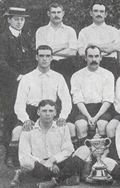 I had a look at Geoff Allman's volume in the Images of Sport series where there are several team photographs taken between 1896 and 1911 all with the team in white. However, the Football League handbooks of this period consistently record Wolves' colours as old gold and black and there is plenty of phorographic evidence to support this. Furthermore the caption on this 1908-09 photograph states the team's colours are old gold and black (click thumbnail right to see the whole image).
I had a look at Geoff Allman's volume in the Images of Sport series where there are several team photographs taken between 1896 and 1911 all with the team in white. However, the Football League handbooks of this period consistently record Wolves' colours as old gold and black and there is plenty of phorographic evidence to support this. Furthermore the caption on this 1908-09 photograph states the team's colours are old gold and black (click thumbnail right to see the whole image).
We know that Wolves' shade of old gold was dark, almost brown, and furthermore that much of the film stock used at the time was insensitive to yellow light. I suspect that the photographers had the players wear white because their normal kit would not show up against the dark background. This still leaves the question of why the team wore white against their Black Country rivals in 1905. All I can think of is that as the light 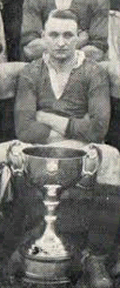 faded on a late November afternoon, Wolves' normal kit disappeared into the murk so they may on occasion have worn white so the players could still be seen towards the end of the match.
faded on a late November afternoon, Wolves' normal kit disappeared into the murk so they may on occasion have worn white so the players could still be seen towards the end of the match.
Historical Updates
Barnet (1931-36 added - photo left): Barnsley (1997-98 crest positioned correctly): Doncaster Rovers (2014-15 sleeves corrected): Brechin City (1995-96 detailing updated): Montrose (1973-74, 1984-85 detailing corrected; 1997-98 shirt trim corrected; crest history added): Dundee (now established that the team wore black and not dark blue knickers 1896-1901): Yeovil Town (1973-74 added): Sunderland (1988-81, 1994-96 sponsorship modified; 1977 crest corrected): Plymouth Argyle (now confirmed that Argyle dropped their green/black striped shirts for green/white ones in November 1974).
25 August - Romania in the 1930s Follow Up
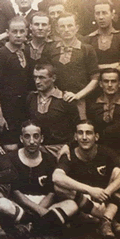 Our old friend Franc Forjan has been in touch to point out that the Yugoslavian team travelled to Uruguay on the MS Florida from Marseille to Montevideo so the players seated in the photographs must be from somewhere else. I have amended the 22 August entry accordingly.
Our old friend Franc Forjan has been in touch to point out that the Yugoslavian team travelled to Uruguay on the MS Florida from Marseille to Montevideo so the players seated in the photographs must be from somewhere else. I have amended the 22 August entry accordingly.
The SS Conte Verde did stop at Rio de Janeiro to pick up the Brazilian squad but the mystery players are certainly not wearing Brazilian shirts nor do I think the tops belong to any of the clubs that provided players. Any ideas?
Evandro Bettancourt has been in touch in support of our new interpretation of Romania's colours. You may want to visit his blog where he has his own graphic record of the World Cup.
2015-16 Update
Premier League: West Ham United (3rd), Chelsea (3rd).
League One: Fleetwood Town (2nd*), Port Vale (2nd*).
League Two: York City (2nd shirt trim corrected).
SPFL Championship: Raith Rovers (3rd).
22 August - Romania in the 1930s Revisited
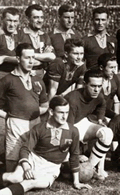 Let's start with new evidence on a long-standing puzzle, namely what colours did the Romanian team wear in the 1930s? I had settled on blue shirts and
Let's start with new evidence on a long-standing puzzle, namely what colours did the Romanian team wear in the 1930s? I had settled on blue shirts and 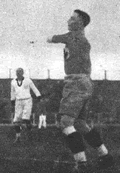 yellow shorts suggested by this photograph (left) before the match with Uruguay in the 1930 World Cup. Greger Lindberg has challenged this, correctly stating that there is no evidence that yellow shorts were available at this time and suggesting that the variations apparent in different matches (right) are due to the peculiarities of the film stock used at the time (something Greger was instrumental indiscovering).
yellow shorts suggested by this photograph (left) before the match with Uruguay in the 1930 World Cup. Greger Lindberg has challenged this, correctly stating that there is no evidence that yellow shorts were available at this time and suggesting that the variations apparent in different matches (right) are due to the peculiarities of the film stock used at the time (something Greger was instrumental indiscovering).
Recently Esteban Catalán submitted three photographs taken on board the SS Conte Verde(left) that allows us to compare and contrast the kit worn by the four European sides on the long voyage to Montevideo. From this we 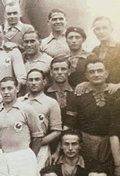 can see that Romania's shirts are the same tone as those of Belgium and we know these were red (click the image to see the full group). By way of contrast, the French team's mid blue shirts appear pale, conclusive evidence that Romania wore red tops and not blue. We can explain the variations in the colour of their shorts if we consider that much of the film stock in use at the time was insensitive to blue light (which is why the French shirts seem so light.)
can see that Romania's shirts are the same tone as those of Belgium and we know these were red (click the image to see the full group). By way of contrast, the French team's mid blue shirts appear pale, conclusive evidence that Romania wore red tops and not blue. We can explain the variations in the colour of their shorts if we consider that much of the film stock in use at the time was insensitive to blue light (which is why the French shirts seem so light.)
Seated at the front are ten players evidently 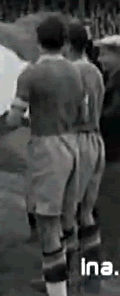 wearing dark (ie red) tops. Their identity is a mystery.
wearing dark (ie red) tops. Their identity is a mystery.
If we assume that Romania wore red shirts throughout the 1930s, we can explain why 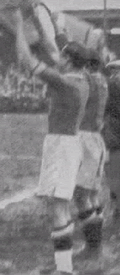 Czechoslovakia changed into white shirts when they met in the 1934 competition.
Czechoslovakia changed into white shirts when they met in the 1934 competition.
When Romania played Cuba in 1938, photographs (left) suggest they wore pale shorts but cine film from the same match (right) show conclusively that they were in fact mid-blue.
Other Historical Material
This photograph, submitted by Roy Cathcart, is of the Irish international team that played Wales in April 1893, wearing the pale shade of St Patrick's blue that was their signature colour until the First World War. Note that the players are wearing a mixture of white, navy and blackknickers as well as varied socks. Like the (English) FA, the Irish FA supplied the team's shirts but players had to bring their own knickers 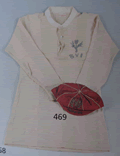 and socks.
and socks.
This shirt (right) was sold at auction in 2002 and was worn by Nick Smith (Rangers) for Scotland against Ireland in 1899, 1900 or 1901. Although 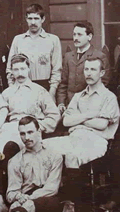 badly faded, the colours of Lord Roseberry are evident, arranged as vertical stripes rather than the familiar hoops. I have provisionally dated this as being from 1899 in which case it would have been a change shirt. Thanks to William Mackie for this item.
badly faded, the colours of Lord Roseberry are evident, arranged as vertical stripes rather than the familiar hoops. I have provisionally dated this as being from 1899 in which case it would have been a change shirt. Thanks to William Mackie for this item.
Northern Ireland borrowed a set of socks from Hungary when the teams met inBudapest in October 1988.
AFC Bournemouth (2001-02 added; 1987-88, 1998-99 detailing amended): Coventry City (1883 [left], 1914-15, 1927-28, 1936-37added; 1907-09, 1996-97 socks corrected).
19 August 2015-16 Update
Premier League: Manchester United (Champions League kit).
NIFL Premiership: Ballymena United (2nd), Carrick Rangers (1st 2nd), Cliftonville (2nd*), Coleraine (1st* 2nd*), Dungannon Swifts (1st 2nd), Glenavon (2nd), Glentoran (2nd), Linfield (sponsor added), Warrenpoint Town (1st* 2nd*). This complete the NIFL section.
17 August
Welsh Premier League: Aberystwyth Town (1st* 2nd), Bala Town (1st), Bangor City (1st 2nd), Carmarthen Town (1st 2nd), Gap Connah's Quay Nomads (1st 2nd), Haverfordwest County (1st 2nd), MBi Llandudno (1st 2nd), Newtown (1st 2nd), Port Talbot Town (2nd), Rhyl (1st 2nd). This completes the WPL section.
15 August - 2015-16 Update
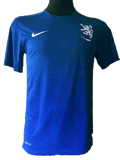 Rangers Supporters' Trust has set up a partnership to produce a range of unofficial shirts for fans who wish to support their club while protesting against the current arrangement that sees Sports Direct take the bulk of the profits from merchandising. Profits are used to increase supporters' shareholding in the club. Read more and order your shirt...
Rangers Supporters' Trust has set up a partnership to produce a range of unofficial shirts for fans who wish to support their club while protesting against the current arrangement that sees Sports Direct take the bulk of the profits from merchandising. Profits are used to increase supporters' shareholding in the club. Read more and order your shirt...
SPFL Premier League: Celtic (3rd shorts & socks confirmed, kit worn in Iceland added), St Johnstone (1st detailing added).
SPFL Championship: Alloa Athletic (2nd), Greenock Morton (1st shorts updated).
SPFL League One: Brechin City (2nd), Cowdenbeath (1st), Forfar Athletic (1st*). Airdrieonians are wearing last season's Puma strips pending delivery of their new sets.
SPFL League Two: Elgin City (1st 2nd), East Fife 1st socks amended, 2nd added), Annan Athletic (1st* 2nd*), Stirling Albion (1st 2nd), Queen's Park (1st* 2nd*), East Stirlingshire (2nd*), Arbroath (1st 2nd*), Berwick Rangers (1st).
*Unchanged
Only three clubs have yet to reveal their change strips and these will be added to the 2015-16 season galleries as soon as they are available. We can also expect a rash of third and charity strips and I will, as usual, add these as they appear. I have to thank the very many contributors who have submitted details of new kits over the summer: your contributions are vital to HFK. Thank you.
I shall update the Welsh and Irish Premier League sections next before turning to the mass of fascinating historical material currently sitting in HFK Towers' email annex.
14 August - 2015-16 Update
League One: Doncaster Rovers (2nd).
League Two: Hartlepool United (2nd kit sponsorship confirmed).
Former members: Cheltenham Town, Kidderminster Harriers, Stockport County.
13 August - 2015-16 Update
Premier League: Tottenham Hotspur (3rd), Leicester City (3rd), Arsenal (3rd), Manchester United (2nd).
Championship: Reading (2nd), Fulham (sponsorship confirmed).
League One: Shrewsbury Town (3rd).
League Two: Accrington Stanley (sponsorship changed), Portsmouth (3rd), Exeter City (1st & 3rd socks updated), Newport County (1st).
9 August - 2015-16 Update
Premier League: Everton (3rd).
Championship: Hull City (2nd).
League One: Blackpool (2nd and sponsorship added). Peterborough United (2nd).
League Two: Oxford United (2nd), Luton Town (1st 2nd 3rd).
3 August - 2015-16 Update
Premier League: Newcastle United (2nd).
Championship: Fulham (1st 2nd 3rd*), Bristol City (2nd).
League One: Sheffield United (2nd).
League Two: Leyton Orient (1st 2nd 3rd).
*Unchanged.
2 August - 2015-16 Update
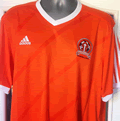 The Toon Army are not alone in donning unofficial replica shirts as a protest against their club's ownership. Seasiders' fans also have an alternative, supported by the Blackpool Supporters Trust as part of their campaign to buy the club from the Oyston family. The current chairman, Karl Oyston, is at the centre of fans' deep disatisfaction and was recently handed a £40,000 fine and ordered to complete an FA educational programme or be banned from all footballing activity after an exyended exchange of offensive and abusive text messages with a supporter. Read more & order...
The Toon Army are not alone in donning unofficial replica shirts as a protest against their club's ownership. Seasiders' fans also have an alternative, supported by the Blackpool Supporters Trust as part of their campaign to buy the club from the Oyston family. The current chairman, Karl Oyston, is at the centre of fans' deep disatisfaction and was recently handed a £40,000 fine and ordered to complete an FA educational programme or be banned from all footballing activity after an exyended exchange of offensive and abusive text messages with a supporter. Read more & order...
Premier League: Manchester United (1st).
Championship: Huddersfield Town (1st).
League Two: Yeovil Town (2nd), Notts County (1st 2nd 3rd), Annan Athletic (1st*).
*Unchanged.
29 July - 2015-16 Update
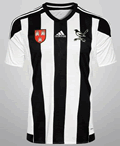 Now here's an interesting development. A group of Newcastle supporters yesterday launched "The Magpie Shirt," an alternative to the official club merchandise. According to their website, The Magpie brand allows fans to represent their club with pride. Without unethical loan shark sponsorship ....all products are sold at cost price, hitting Sports Direct and Mike Ashley in the pocket to signal that we demand a club that tries. Initial stock sold out within two hours but more shirts are on order. Read more & order...
Now here's an interesting development. A group of Newcastle supporters yesterday launched "The Magpie Shirt," an alternative to the official club merchandise. According to their website, The Magpie brand allows fans to represent their club with pride. Without unethical loan shark sponsorship ....all products are sold at cost price, hitting Sports Direct and Mike Ashley in the pocket to signal that we demand a club that tries. Initial stock sold out within two hours but more shirts are on order. Read more & order...
Premier League: Watford (2nd).
Championship: Ipswich Town (3rd), Derby County (2nd), Queen's Park Rangers (special), Bolton Wanderers (2nd), Leeds United (2nd).
League Two: Cambridge United (2nd).
28 July - 2015-16 Update
SPFL Premier League: Partick Thistle (2nd), Kilmarnock (2nd), Hamilton Academical (1st 2nd).
SPFL Championship: Dumbarton (1st sponsorship confirmed, 2nd).
SPFL League Two: East Fife (1st), Berwick Rangers (2nd).
NIFL Premiership: Ballinamallard United (1st* 2nd).
26 July - 2015-16 Update
Premier League: AFC Bournemouth (3rd), Manchester City (2nd).
Championship: Blackburn Rovers (2nd), Brentford (1st shorts detailing added).
League One: Doncaster Rovers (1st), Rochdale (detailing on shorts/socks updated), Walsall (2nd).
League Two: Mansfield Town (2nd), Northampton Town (1st 2nd 3rd*), Bristol Rovers (1st 2nd), Oxford United (1st).
24 July - 2015-2016 Update
Premier League: Chelsea (2nd), Norwich City (3rd).
Championship: Birmingham City (2nd), Burnley (2nd).
League One: Southend United (1st 2nd), Burton Albion (2nd*).
League Two: Barnet (1st 2nd).
18 July
 Several teams have adopted the Puma Swerve shirt as an alternative strip for the coming season prompting Glyn Jefferson to wonder where he had seen it before. After a
Several teams have adopted the Puma Swerve shirt as an alternative strip for the coming season prompting Glyn Jefferson to wonder where he had seen it before. After a 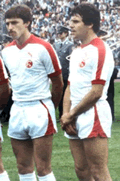 little digging he found this top worn by Werder Bremen as far back as 1989-90. It appears that far from being a new design, Swerve dates back 25 years. Incidentally, the very popular Puma Pitch design is similar to the very first kits that Puma supplied to European clubs in the mid 1970s with the characteristic formstripe feature, worn here by Fortuna Düsseldorf in 1976.
little digging he found this top worn by Werder Bremen as far back as 1989-90. It appears that far from being a new design, Swerve dates back 25 years. Incidentally, the very popular Puma Pitch design is similar to the very first kits that Puma supplied to European clubs in the mid 1970s with the characteristic formstripe feature, worn here by Fortuna Düsseldorf in 1976.
(Photograph courtesy of Classic Football Shirts.)
2015-16 Update
Premier League: Sunderland (2nd).
League Two: Exeter City (3rd).
SPFL Premier League: St Johnstone (2nd).
NIFL Premiership: Ballymena United (2nd*)
17 July - 2015-16 Update
Premier League: Leicester City (2nd), Tottenham Hotspur (2nd), Chelsea (1st).
Championship: Preston North End (2nd), Cardiff City (2nd), Nottingham Forest (2nd).
League One: Colchester United (1st 2nd).
League Two: AFC Wimbledon (3rd), Yeovil Town (1st).
SPFL Premier League: Inverness Caledonian Thistle (1st 2nd)
SPFL Championship: Queen of the South (sponsorship confirmed), Rangers (3rd).
15 July - 2015-16 Update
Premier League: Norwich City (2nd), Arsenal (2nd socks updated), AFC Bournemouth (2nd), West Ham United (2nd).
Historical Material
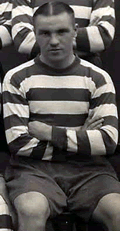 Featured in this photograph sent in by Dean Beresford is the great Bill Shankly in an unfamiliar strip. This is in fact from his time with Preston North End who wore navy and white hooped jerseys when a change was needed. This is the side that reached the FA Cup final in 1937. Note the very modern looking crew necks which were very unusual in this period. Click on the image to view the entire team - Dean's grandfather, Joe Beresford, is seated on the right.
Featured in this photograph sent in by Dean Beresford is the great Bill Shankly in an unfamiliar strip. This is in fact from his time with Preston North End who wore navy and white hooped jerseys when a change was needed. This is the side that reached the FA Cup final in 1937. Note the very modern looking crew necks which were very unusual in this period. Click on the image to view the entire team - Dean's grandfather, Joe Beresford, is seated on the right.
Sunderland (1994-96, 1996-97 logos and sponsorship tweaked): Liverpool (1956-58 cold weather kit added): Huddersfield Town (Roger Pashby has confirmed warm and cold weather kits for 1970-71): Yeovil Town (1972-73 added): Rangers (2000-01 change kit detailing improved): Sunderland (2012-13 Foundation of Light kit added): Manchester City (1971-72 correct badge applied).
14 July - 2015-16 Update
Premier League: AFC Bournemouth (1st), Everton (2nd).
Championship: Hull City (1st), Birmingham City (1st).
League One: Blackpool (1st).
League Two: Dagenham & Redbridge (2nd*).
Former members: Boston United, Lincoln City, Macclesfield Town.
SPFL Premier League: Dundee (2nd).
SPFL Championship: Alloa Athletic (sponsorship added), Hibernian (2nd).
SPFL League Two: East Stirlingshire (1st*).
NIFL Premiership: Portadown (1st 2nd).
Welsh Premier League: Bala Town (2nd Europa League 1st & 2nd), Airbus UK Broughton (1st* 2nd), Newtown (Europa League 1st), The New Saints (1st 2nd), Port Talbot Town (1st).
11 July - 2015-16 Update
Premier League: Aston Villa (1st 2nd), Crystal Palace (sponsorship added), West Bromwich Albion (2nd sponsorship updated).
Championship: Charlton Athletic (2nd 3rd), Leeds United (1st).
League One: Barnsley (2nd), Scunthorpe United (sponsorship updated), Bury (1st 2nd), Coventry City (2nd).
League Two: Carlisle United (1st 2nd), Mansfield Town (1st), York City (1st 2nd), Hartlepool United (1st).
The missing graphics from the last update have now been fixed.
7 July - 2015-16 Update
Championship: Middlesbrough (2nd socks corrected), Sheffield Wednesday (2nd).
League One: Peterborough United (1st), Scunthorpe United (1st 2nd).
SPFL Championship: Livingston (1st 2nd).
SPFL League One: Peterhead (1st 2nd), Dunfermline Athletic (1st 2nd).
SPFL League Two: Montrose (sponsorship added).
6 July
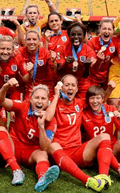 Our warmest congratulations to England's women's team who overcame Germany, ranked number one in the world, to bring home the bronze medal from the 2015 Women's World Cup. It is a salutory thought that the total salary bill for the entire women's squad is less than £1m a year while the captain of the England men's team, Wayne Rooney, is on £17m. The boys could take some lessons in how to play with passion and commitment from their female counterparts.
Our warmest congratulations to England's women's team who overcame Germany, ranked number one in the world, to bring home the bronze medal from the 2015 Women's World Cup. It is a salutory thought that the total salary bill for the entire women's squad is less than £1m a year while the captain of the England men's team, Wayne Rooney, is on £17m. The boys could take some lessons in how to play with passion and commitment from their female counterparts.
(Photograph courtesy of the FA.)
4 July - 2015-16 Update
Premier League: Manchester City (1st).
Championship: Middlesbrough (2nd), MK Dons (1st, 2nd, 3rd), Reading (1st), Brighton & Hove Albion (2nd, 3rd).
League One: Chesterfield (1st 2nd).
League Two: Accrington Stanley (1st 2nd*), Dagenham & Redbridge (1st).
SPFL Premier League: Motherwell (1st 2nd).
SPFL League One: Cowdenbeath (2nd), Stenhousemuir (1st 2nd).
SPFL League Two: Montrose (1st 2nd)
Norwich City (2014-15 charity strip added).
2 July
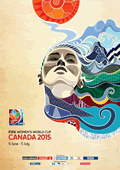 It's hard to imagine a more cruel way for England's Lionesses to be eliminated from the Women's World Cup than the freakish own goal in injury time that put Japan through to the final. The team have given everything and can hold their heads up high.
It's hard to imagine a more cruel way for England's Lionesses to be eliminated from the Women's World Cup than the freakish own goal in injury time that put Japan through to the final. The team have given everything and can hold their heads up high.
Which brings us to our new feature - the complete kit archive of the 2015 FIFA Women's World Cup is now open.
As time allows, I will add previous tournaments until we have a complete record from 1991 to the present.
1 July - 2015-16 Update
Premier League: Norwich City (1st), West Bromwich Albion (1st).
Championship: Queens Park Rangers (1st, 2nd, 3rd).
League Two: Morecambe (1st, 2nd, 3rd).
SPFL Premier League: Partick Thistle (1st), Heart of Midlothian (2nd corrected).
SPFL League One: Airdrieonians (1st, 2nd).
NIFL Premiership: Linfield (1st*).
*Unchanged.
29 June - 2015-16 Update
Championship: Huddersfield Town (2nd).
League One: Wigan Athletic (1st. 2nd, 3rd), Coventry City (1st).
NIFL Premiership: Linfield (2nd).
26 June - 2015-16 Update
Championship: Bolton Wanderers (1st), Nottingham Forest (1st).
Former members: Torquay United (1st).
SPFL Premier League: Aberdeen (2nd).
SPFL Championship: Dumbarton entry corrected.
NIFL Premiership: Cliftonville (1st), Ballymena United (1st), Glenavon (1st).
The Welsh Premier League section is now open (but empty!).
The MLS section now has "Buy From" links so that you can purchase American/Canadian replica shirts from one of our affiliate partners.
20 June - 2015-16 Update
Premier League: Arsenal (3rd), Newcastle United (3rd), West Ham United (1st), Swansea City (2nd corrected).
Championship: Cardiff City (1st).
SPFL Premier League: Dundee United (2nd), Ross County (1st, 2nd).
SPFL Championship: St Mirren (1st), Dumbarton (1st* 2nd*).
SPFL League Two: Clyde (1st, 2nd, 3rd).
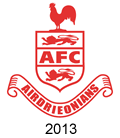 You may have missed the extraordinary story behind Airdrieonians new crest so here's the skinny. The club has been forced to sign an irrevocable undertaking to drop its historical crest following the intervention of the Court of the Lord Lyon, which oversees heraldic law in Scotland. According to the Clerk of the Court the badge
You may have missed the extraordinary story behind Airdrieonians new crest so here's the skinny. The club has been forced to sign an irrevocable undertaking to drop its historical crest following the intervention of the Court of the Lord Lyon, which oversees heraldic law in Scotland. According to the Clerk of the Court the badge 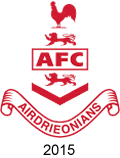 constitutes "an heraldic device" and must be registered. Under a 16th century statute, however, letters or numbers may not be included so the crest cannot be registered and it is illegal to use an unregistered device. Penalties include fines and forfeiture of the offending crest. Historically offenders could be imprisoned, have their goods seized and be subject to Letters of Horning.
constitutes "an heraldic device" and must be registered. Under a 16th century statute, however, letters or numbers may not be included so the crest cannot be registered and it is illegal to use an unregistered device. Penalties include fines and forfeiture of the offending crest. Historically offenders could be imprisoned, have their goods seized and be subject to Letters of Horning.
The absurdity of the affair notwithstanding, serious issues are raised. The Lord Lyon has form : Kilmarnock (1993), St Mirren (1996) and Highland League team, Formatine United (2012) have all been forced to change traditional crests after intervention from the court and many more clubs could be affected.
The Airdrieonians Supporters' Trust and Supporters Direct Scotland have launched a petition and HFK urges visitors to follow this link to read more about the affair and sign the petition.
Although similar rules apply in England, heraldic law is a civil matter and the High Court of Chivalry has met only once in the last 250 years.
18 June - 2015-16 Update
Premier League: Arsenal (1st, 2nd).
Championship: Burnley (1st), Fulham (2nd*).
SPFL Premier League: Dundee (1st).
SPFL Championship: Alloa Athletic (1st).
SPFL League One: Albion Rovers (1st).
MLS: Sporting Kansas City 1st corrected, Seattle Sounders 3rd added.
IFA Premiership: Now open
13 June - 2015-16 Update
Premier League: West Bromwich Albion (2nd) Sunderland (1st), Swansea City (2nd), Southampton (2nd).
Championship: Preston North End (1st), Derby County (1st), Wolverhampton Wanderers (2nd).
SPFL Premier League: Celtic (2nd, 3rd), St Johnstone (1st).
SPFL Championship: Queen of the South (1st, 2nd, 3rd), Raith Rovers (1st, 2nd*).
*Unchanged
10 June - 2015-16 Updates
UEFA Champions League Final added.
Premier League: Swansea City (1st).
Championship: Rotherham United (2nd corrected).
League One: Barnsley (1st), Millwall (1st).
SPFL Championship: Rangers (2nd)
2 June - 2015-16 Update
FA Cup: Saturday's final added.
Premier League: Southampton (1st).
Championship: Rotherham United (2nd, 3rd), Sheffield Wednesday (1st).
League One: Swindon Town (1st, 2nd).
League Two: Exeter City (1st* 2nd*), Plymouth Argyle (2nd), Cambridge United (1st).
SPFL Premier: Kilmarnock (1st).
SPFL Championship: Greenock Morton (1st*, 2nd).
28 May - 2015-16 Update
Championship: Brighton & Hove Albion (1st*).
League One: Oldham Athletic (1st, 2nd).
League Two: Portsmouth (2nd), Stevenage (1st).
SPFL League One: Albion Rovers (2nd), Ayr United (1st, 2nd), Stranraer (1st*, 2nd, 3rd*).
*unchanged.
27 May - 2015-16 Season Galleries Now Open
Our eagerly awaited club galleries for the new season are now open. As usual, please e-mail me with details of new kits as they appear: first into the mailbox gets a credit on the site. Please note that I need details of the full kit, not just the shirt, and of course, I do not work from leaked images, so don't send me any.
It is against the law to smoke on these premises.
23 May - 2015-16 Kits
Watford, Crawley Town, Walsall, Everton, Newcastle United, Cardiff City (new crest).
Historical Updates
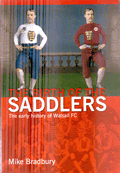 I have been in correspondence with Mike Bradbury, author of The Birth of the Saddlers, over his theory that Walsall Swifts, the working class team that eventually merged with the middle-class Walsall Town to form the modern club, wore an all-maroon kit around 1880. With one or two exceptions, the knickers available at the time were navy, black or white. Mike has, however, established from the catalogue of the only sports outfitter in the town, that they did not sell maroon jerseys although it is documented that the club adopted this colour in 1879. Enquiries at the Walsall Leather Museum have established that the players would have had ready access to coloured dyes used in the tanning industry where they were all employed, including maroon. It therefore seems probable that they dyed their jerseys to make them more distinctive and furthermore they also treated their knickers to create a unique playing strip.
I have been in correspondence with Mike Bradbury, author of The Birth of the Saddlers, over his theory that Walsall Swifts, the working class team that eventually merged with the middle-class Walsall Town to form the modern club, wore an all-maroon kit around 1880. With one or two exceptions, the knickers available at the time were navy, black or white. Mike has, however, established from the catalogue of the only sports outfitter in the town, that they did not sell maroon jerseys although it is documented that the club adopted this colour in 1879. Enquiries at the Walsall Leather Museum have established that the players would have had ready access to coloured dyes used in the tanning industry where they were all employed, including maroon. It therefore seems probable that they dyed their jerseys to make them more distinctive and furthermore they also treated their knickers to create a unique playing strip.
An interesting variant kit worn by Plymouth Argyle in January 1975 added.
19 May - 2015-16 Kits
Hibernian, Dundee United, Portsmouth, Plymouth Argyle.
Historical Updates
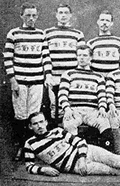 I have replaced the scruffy team photograph on the Hibernian page with this one from 1876, the year the club was grudgingly admitted to the Edinburgh FA, from the excellent Hibernian Historical Trust website. The hooped jerseys are very similar to those adopted by Hearts at the time, even down to the gothic lettering across the chest and probably came from the same gentlemen's outfitter.
I have replaced the scruffy team photograph on the Hibernian page with this one from 1876, the year the club was grudgingly admitted to the Edinburgh FA, from the excellent Hibernian Historical Trust website. The hooped jerseys are very similar to those adopted by Hearts at the time, even down to the gothic lettering across the chest and probably came from the same gentlemen's outfitter.
Bristol City (crest history updated); Queen's Park Rangers (centenary crest added).
15 May - 2015-16 Kits
Crystal Palace, Middlesbrough, Ipswich Town, Tottenham Hotspur.
14 May
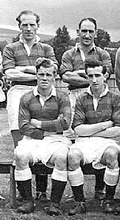 I have substantially updated the Ross County page, adding several previously unrecorded kits that fill many of the gaps in the record as well as a crest history. The main source for this new material is the Ross County FC Team Photos website, where you will find a fine collection going back to 1929 when the club was founded. This image is from 1949-50 when the team adopted red and blue hooped jerseys. The familiar navy and white colours did not appear until 1953.
I have substantially updated the Ross County page, adding several previously unrecorded kits that fill many of the gaps in the record as well as a crest history. The main source for this new material is the Ross County FC Team Photos website, where you will find a fine collection going back to 1929 when the club was founded. This image is from 1949-50 when the team adopted red and blue hooped jerseys. The familiar navy and white colours did not appear until 1953.
13 May - 2015-16 Kits
Falkirk, Aberdeen, Heart of Midlothian, Bristol City (new version of crest added), Wolverhampton Wanderers, Grimsby Town, Wrexham, Rotherham United, Blackburn Rovers.
Barnsley 2014-15 3rd kit added.
5 May
Before the new season's club kits start flooding in, I'm going to deal with the World Cup updates that have been piling up in the HFK in tray.
 The colours worn by the Romanian team throughout the 1930s have long been a bit of a puzzle and I am not convinced that the details furnished to me by the Romanian Football Federation are correct. Our old friend from Brazil, André Conceição e Silva, has sent me two thoughtfully argued emails with supporting photographs suggesting that the team wore blue shirts with yellow collars and knickers. On the left is the team from the 1930 tournament. The apparently white socks are misleading: I believe the players are wearing cavigliere (ankle supports) that were popular in Europe at the time.
The colours worn by the Romanian team throughout the 1930s have long been a bit of a puzzle and I am not convinced that the details furnished to me by the Romanian Football Federation are correct. Our old friend from Brazil, André Conceição e Silva, has sent me two thoughtfully argued emails with supporting photographs suggesting that the team wore blue shirts with yellow collars and knickers. On the left is the team from the 1930 tournament. The apparently white socks are misleading: I believe the players are wearing cavigliere (ankle supports) that were popular in Europe at the time.
1930 - Romania amended.
1934 - Romania amended. Spain crest improved.
1938 - Romania amended.
1954 - West Germany's socks were green not black in their play-off with Turkey. South Korea's shirts had white cuffs.
1958 - Austria crest corrected. Red patch added to the crest of Wales' yellow shirt.
1958 - Austria's change shirts had long sleeves.
1986 - Iraq minor shorts detailing altered.
1994 - Bolivia crest and collar detailing corrected. The flag on Norway's change strip is now correct - the design was different to their first choice strip..
2014 - Uruguay texture added behind crest.
4 May - 2015-16 Kits
Bristol City, Tranmere Rovers, Charlton Athletic, Stoke City, Celtic, Port Vale, Crewe Alexandra, Shrewsbury Town, Sporting Kansas City (3rd).
Bury's 130th anniversary strip has been added.
29 April
Fleetwood Town, Bradford City 2015-16 kits added.
I have revised the Lincoln City graphics 1985-2001 with missing detailing and added several crests.
28 April
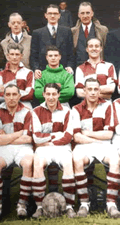 Research by supporters of Wigan Athletic has shed new light on the change of colours that occured after the Second World War. It had been thought that this was forced on the club because they could not source their pre-war red/white halved shirts but this photograph (colourised by our old friend, George Chilvers) shows them wearing quartered shirts in pre-war colours in 1946-47, their last in the Cheshire League. The following season they joined the Lancashire Combination and, according to the programme notes from their opening match against Fleetwood, "Our players will appear in the club's new colours - Blue and White - and their shirts will be numbered according to their positions."
Research by supporters of Wigan Athletic has shed new light on the change of colours that occured after the Second World War. It had been thought that this was forced on the club because they could not source their pre-war red/white halved shirts but this photograph (colourised by our old friend, George Chilvers) shows them wearing quartered shirts in pre-war colours in 1946-47, their last in the Cheshire League. The following season they joined the Lancashire Combination and, according to the programme notes from their opening match against Fleetwood, "Our players will appear in the club's new colours - Blue and White - and their shirts will be numbered according to their positions."
Grimsby Town (first black/white striped shirt now correctly dated to 1910-11; minor tweaks to graphics 1975-85): Wimbledon (1976-77 white strip restored): Crawley Town (1890-1902 knickers now confirmed, 1925-26 added): Celtic (trim added to 1968-69 third strip): Rangers (1997-99, 1999-01 amended; 1999-00 change corrected): Aberdeen (1998-00 socks corrected): Elgin City (1919-26, 1926-28, 1928-31, 1931-34 added; 1934-41 dates revised).
15 April
Liverpool and Sheffield United are the first clubs to reveal their 2015-16 kits.
14 April
 Thanks to Mike Bradbury's entertainingly discursive "Birth of the Saddlers" I have been able to substantially update the Walsall section with new graphics and background information on the precursor clubs, Walsall Town and Walsall Swifts in the 19th century.
Thanks to Mike Bradbury's entertainingly discursive "Birth of the Saddlers" I have been able to substantially update the Walsall section with new graphics and background information on the precursor clubs, Walsall Town and Walsall Swifts in the 19th century.
9 April
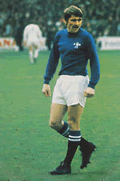 Here's a little coda to the story I ran in January about the variant strip worn by Chelsea 1973-75 and shown here on the
Here's a little coda to the story I ran in January about the variant strip worn by Chelsea 1973-75 and shown here on the 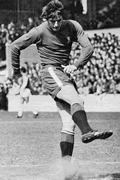 left. HFK's elves discovered that this was worn to avoid a sock clash against Leeds United and others. Management thought that their regular blue shorts would make the kit "too dark" so kitted the team out with white ones. Now Keith Ellis has found this image from a match against West Ham United showing the "dark kit" in action. Examining the image closely, however, I noted that there are no stars on the crest, suggesting this is an earlier iteration of this variant from the period 1968-70. I later found this footage showing Chelsea in an identical strip at Elland Roadin 1969-70.
left. HFK's elves discovered that this was worn to avoid a sock clash against Leeds United and others. Management thought that their regular blue shorts would make the kit "too dark" so kitted the team out with white ones. Now Keith Ellis has found this image from a match against West Ham United showing the "dark kit" in action. Examining the image closely, however, I noted that there are no stars on the crest, suggesting this is an earlier iteration of this variant from the period 1968-70. I later found this footage showing Chelsea in an identical strip at Elland Roadin 1969-70.
This fine photograph, sent in by Jim Jenkinson, shows Dumbarton Athletic, a team that was absorbed by Dumbarton in 1889. Although it is not dated, I believe 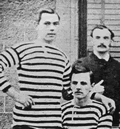 it to be from between 1885 and 1887 when SFA records tell us the team played in black and white stripes. This term was widely used to describe the one-inch hooped jerseys that were common in Scotland at the time.
it to be from between 1885 and 1887 when SFA records tell us the team played in black and white stripes. This term was widely used to describe the one-inch hooped jerseys that were common in Scotland at the time.
Fulham (1902-03 added): Charlton Athletic (1946-47 crest corrected): Wimbledon (1975-77 corrected): Crawley (1890 added): Luton Town (1898-99 added):
3 April
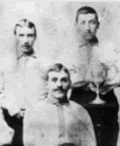 This is Leicester Fosse pictured in 1890-91, the season that
This is Leicester Fosse pictured in 1890-91, the season that 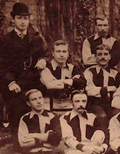 they adopted white shirts for the first time. I have enhanced the contrast to show the collar details and I have assumed these were light blue. This is a previously undocumented strip: plain white shirts were used between 1892 and 1899. We have also established that the previous chocolate and blue shirts had an enormous pocket on the left breast.
they adopted white shirts for the first time. I have enhanced the contrast to show the collar details and I have assumed these were light blue. This is a previously undocumented strip: plain white shirts were used between 1892 and 1899. We have also established that the previous chocolate and blue shirts had an enormous pocket on the left breast.
This rare photograph is of the original Workington AFC team taken in 1905-06. Formed in 1884, the club was wound up in 1911 due to 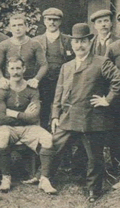 the financial difficulties involved in running a professional football side on the remote Cumbrian coast, a Rugby League stronghold. It is considered to be the precursor of the modern team which was formed in 1921 and, despite facing the same challenges, still exists.
the financial difficulties involved in running a professional football side on the remote Cumbrian coast, a Rugby League stronghold. It is considered to be the precursor of the modern team which was formed in 1921 and, despite facing the same challenges, still exists.
The original postcard is on sale at Sports Pages.
I have finished replenishing the Buy From links for the Premier/Football League club pages and FA Cup section. Many of the items that are out of stock at Toffs can now be found with our other affiliate partners but I suggest you buy soon as I suspect once these are sold out that will be it. As far as possible I have removed obsolete links and added new ones for items that have come onto the market. I plan to review all Scottish club links shortly.
29 March
The decision by West Bromwich Albion to wear a replica of their 1968 FA Cup final strip to honour the launch of the Jeff Astle Foundation has prompted much favourable comment in social media. Other charity kits added today include Tottenham Hotspur, Bolton Wanderers, Reading and Leyton Orient.
Colorado Rapids (new shirt sponsor added).
Please bear with me as I am currently doing some housekeeping on the site and will resume normal updates soon. In particular, Toffs have drastically reduced their catalogue rendering many of our "Buy From" links obsolete. Some of the out of stock items are now available from other retailers and I am replacing these links.
6 March
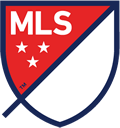 MLS kicks off in North America this weekend with a new logo and two new teams. This has been "MLS Jersey Week" during which all the new kits have been launched with the exception of NewYork City and Orlando City, who revealed their new shirts some time ago. So, ladies and gentlemen, you are now welcome to visit our new MLS 2015 section.
MLS kicks off in North America this weekend with a new logo and two new teams. This has been "MLS Jersey Week" during which all the new kits have been launched with the exception of NewYork City and Orlando City, who revealed their new shirts some time ago. So, ladies and gentlemen, you are now welcome to visit our new MLS 2015 section.
Thangyou vermurch.
5 March - More Crest History Updates
Fulham, Blackpool, Aston Villa, Hull City.
We have Oleg Baranov to thank once again for the research into crests published over the last week.
3 March - More Crest History Updates
West Ham United, Gretna, Aberdeen, St Johnstone, AFC Bournemouth.
Coming soon - MLS 2015.
27 February
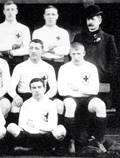 The good people at Frickley Museum have sent us this photograph to see if we can identify the team, which probably played in West Yorkshire. The style of clothing worn by the officials and the length of the players' knickers place this firmly in the period 1900-1914. The team strip of white shirts and dark knickers was very common and is no help but the crest is intriguing as very few teams wore one at the time. Anyone?
The good people at Frickley Museum have sent us this photograph to see if we can identify the team, which probably played in West Yorkshire. The style of clothing worn by the officials and the length of the players' knickers place this firmly in the period 1900-1914. The team strip of white shirts and dark knickers was very common and is no help but the crest is intriguing as very few teams wore one at the time. Anyone?
Crest History Updates
25 February
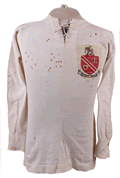 This is the shirt worn by Billy Jennings for Bolton Wanderers in the famous "White Horse FA Cup final" in 1923. Judging by the rust stains, this has spent many years
This is the shirt worn by Billy Jennings for Bolton Wanderers in the famous "White Horse FA Cup final" in 1923. Judging by the rust stains, this has spent many years 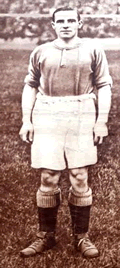 stored improperly but it has at least survived. Had it been in better condition it would no doubt have fetched more than the £6,000 it was sold for last year. The crest details have allowed me to improve the Bolton graphics 1921-1953.
stored improperly but it has at least survived. Had it been in better condition it would no doubt have fetched more than the £6,000 it was sold for last year. The crest details have allowed me to improve the Bolton graphics 1921-1953.
On the right is Alan Morton of Rangers pictured in March 1922. The point of interest is that he is wearing the iconic black socks with red turnovers which were introduced that season. However, he is also wearing the older style of shirt with a buttoned crew neck. Collared shirts were introduced the following season and remained in use for 40 years.
18 February International Updates
Northern Ireland: new change strip added.
Embossed crest added to 2009-2011 England shorts. Scotland's aertex kits for World Cup 1986 revised.
World Cup
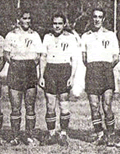 1934: Brazil, Spain collars corrected.
1934: Brazil, Spain collars corrected.
1938: Cuba socks revised (left).
1954: Austria, Hungary crests improved, Mexico shirt buttons added, Czechoslovakia socks amended.
1958: Austria crest improved. Updated Hungary crest applied.
1962: Hungary crest updated.
1966: Hungary crest updated.
1970: Brazil sock turnovers amended.
1974: Brazil sock turnovers amended.
1978: Hungary crest updated.
1986: Detailing added to Spain's shorts, Scotland kit revised.
1990: Korea Republic shirt trim corrected, texture added to Spain shirts.
2010: Missing shorts numbers added to Portugal v Korea DPR, Uruguay collars amended.
11 February
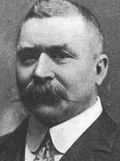 If you think that the current convention of visiting teams changing elements of their strip when there is the slightest suggestion of a clash with those of the home side and that FIFA's
If you think that the current convention of visiting teams changing elements of their strip when there is the slightest suggestion of a clash with those of the home side and that FIFA's  regulations about high levels of contrast are ridiculous, these press cuttings reveal how things might have been. At the 1904 Football League AGM, Liverpool's secretary, John McKenna (left), tabled a motion that would require all teams to play in red shirts or jerseys at home while visitors would wear white tops and dark knickers. The motion was seconded by Sunderland but rejected after some discussion. You might think that McKenna's proposal was tongue in cheek but in1906 he put the motion again with support from Manchester United. Thanks to George Chilvers and Kjell Hanssen for uncovering these
regulations about high levels of contrast are ridiculous, these press cuttings reveal how things might have been. At the 1904 Football League AGM, Liverpool's secretary, John McKenna (left), tabled a motion that would require all teams to play in red shirts or jerseys at home while visitors would wear white tops and dark knickers. The motion was seconded by Sunderland but rejected after some discussion. You might think that McKenna's proposal was tongue in cheek but in1906 he put the motion again with support from Manchester United. Thanks to George Chilvers and Kjell Hanssen for uncovering these 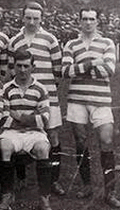 invaluable cuttings
invaluable cuttings ![]() - click on the images to view large versions.
- click on the images to view large versions.
This is a rare photograph of Dumbarton Harp, one of many clubs that sprung from the Irish Catholic community in the late 19th century in Scotland. Taken in 1918-19, Harp were members of the Western League at the time. In 1923 this competition 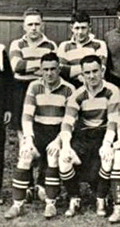 was incorporated into the Scottish League as the new Third Division but in January 1925 Harp resigned and were disbanded due to financial problems. The Third Division itself was abandoned the following season.
was incorporated into the Scottish League as the new Third Division but in January 1925 Harp resigned and were disbanded due to financial problems. The Third Division itself was abandoned the following season.
I've reviewed and updated the Forfar Athletic section and added a crest history. On the left is the Forfar team from 1936 wearing their distinctive light and dark blue shirts.
Liverpool's latest charity kit has been added.
Another Chelsea alternate kit has come to light from Feb 1973. Burton Albion (1971-72 modified): Gretna (crest history added).
10 February
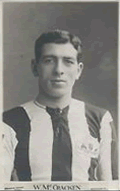 West Ham United's new shirt sponsor has been added.
West Ham United's new shirt sponsor has been added.
Keith Ellis has found this cigarette card showing Billy McCracken of Newcastle United and Ireland wearing a Newcastle shirt with a crest that looks distinctly different to the one worn in FA Cup finals from 1911 on. It is in fact the old city coat of arms and was worn in the 1910 FA Cup final against Barnsley. It can be glimpsed in this YouTube clip.
Chelsea (slight amendments to 1959-60, 1981-83, 1990-92, 2000-01, 2001-02 change kits): Southampton (1924-36 shirt pocket added).
4 February
 There is quite a lot more on Falkirk's early strips and crests today, thanks to Andrew Hewlett. I now have a team
There is quite a lot more on Falkirk's early strips and crests today, thanks to Andrew Hewlett. I now have a team 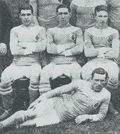 photograph from 1881-82 (left) that shows the embroidery was worn only by the team captain who, as was customary, is seated in the centre of the front row with the ball at his feet. In 1909 the team dropped their navy tops in favour of a lighter shade of blue (right) and we can now see the new tops sported a crest as well as a contrasting yoke.
photograph from 1881-82 (left) that shows the embroidery was worn only by the team captain who, as was customary, is seated in the centre of the front row with the ball at his feet. In 1909 the team dropped their navy tops in favour of a lighter shade of blue (right) and we can now see the new tops sported a crest as well as a contrasting yoke.
On the left is one of Falkirk's first star players, English international Jocky Simpson, in an undated photograph.This shows the lighter blue 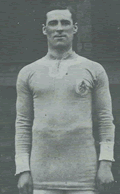 shirt with a unique collar. Since we know that Simpson signed for Blackburn Rovers in January 1911, we can now place this shirt as being
shirt with a unique collar. Since we know that Simpson signed for Blackburn Rovers in January 1911, we can now place this shirt as being 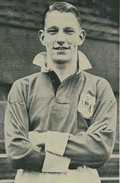 worn in the 1910-11 season.
worn in the 1910-11 season.
Finally, on the right is a photograph of George Anderson wearing a brand new shirt with another hitherto unknown crest dated sometime in the 1930s. After a little research I found his obituary that confirms he played for Falkirk for just one season in 1938-39 before the war interrupted his playing career, which gives us the dates we need rather neatly.
(1906-07, 1909-10, 1910-11, 1938-39 added: 1915-20 collar revised: crest history updated.)
2 February
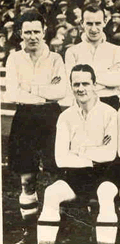 Queen of the South (new crest added): Wolverhampton Wanderers (Nov 1986-88 sponsorship adjusted): Arsenal (1905-06 cuffs corrected).
Queen of the South (new crest added): Wolverhampton Wanderers (Nov 1986-88 sponsorship adjusted): Arsenal (1905-06 cuffs corrected).
Among Steven Ardath's collection of Scottish Football Cards is this rare  photograph of Edinburgh City. The distinctive socks place this in the 1935-36 season.
photograph of Edinburgh City. The distinctive socks place this in the 1935-36 season.
Scottish crest histories added: Edinburgh City, Elgin City, Falkirk. The photograph on the right is from the better meddle website and shows a Falkirk player in a typical 1880s jersey with some intriguing embroidery.
27 January
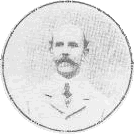 A recurring issue when writing about the early history of football clubs is that all too often inaccurate or self-serving contemporary articles written by club officials are accepted as fact and pass into the authorised histories. A good example of this is the origin of the first Arsenal crest perpetuated by Arthur E Kennedy (left), an early vice-chairman of the club. The work of historians prepared to research primary sources such as Mark Andrews and Andy Kelly rather than rely on repetitious secondary accounts is therefore extremely valuable. On their Arsenal History blog they have conclusively proved that the crest was not adopted in 1888 as official histories state but in fact appeared in an article written by Kennedy for the 1904 Book of Football and never appeared in any club handbook or on their stationary
A recurring issue when writing about the early history of football clubs is that all too often inaccurate or self-serving contemporary articles written by club officials are accepted as fact and pass into the authorised histories. A good example of this is the origin of the first Arsenal crest perpetuated by Arthur E Kennedy (left), an early vice-chairman of the club. The work of historians prepared to research primary sources such as Mark Andrews and Andy Kelly rather than rely on repetitious secondary accounts is therefore extremely valuable. On their Arsenal History blog they have conclusively proved that the crest was not adopted in 1888 as official histories state but in fact appeared in an article written by Kennedy for the 1904 Book of Football and never appeared in any club handbook or on their stationary 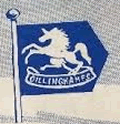 prior to its inclusion in the Official History published in 1986. Kelly and Andrewshave also shared new research that allows me to update the Arsenal Change Kits section.
prior to its inclusion in the Official History published in 1986. Kelly and Andrewshave also shared new research that allows me to update the Arsenal Change Kits section.
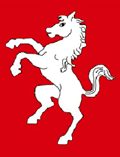 Another example of misleading information is this drawing from the cover of a Gillingham programme from 1958-59 (sent in by Richard Ralph) which suggests the club crest featured a unicorn. Now I'm convinced this is not the case. Examining team photographs and various versions of the Kentish Horse (such as this one from the county's flag) it is clear that the ears and/or mane are often drawn erect giving the appearance from a distance of a unicorn's horn. We can assume that the artist commissioned to design the programme cover was not local as no Man of Kent would make this mistake.
Another example of misleading information is this drawing from the cover of a Gillingham programme from 1958-59 (sent in by Richard Ralph) which suggests the club crest featured a unicorn. Now I'm convinced this is not the case. Examining team photographs and various versions of the Kentish Horse (such as this one from the county's flag) it is clear that the ears and/or mane are often drawn erect giving the appearance from a distance of a unicorn's horn. We can assume that the artist commissioned to design the programme cover was not local as no Man of Kent would make this mistake.
Manchester City (1974-75 Umbro logo added): Chesterfield (1935-37, 1937-38, 1959-62, 1962-64, 2004-05, 2006-07 detailing revised).
24 January
The photograph of Chelsea's Ajax-style shirt prompted Nik Yeomans to sift through his extensive programme collection where he found conclusive evidence that the team wore their regular third strip with the red/green panel and that the top featured on 20 January is a fake. Nik also found an unrecorded change strip from 1963-64.
Current Season Updates
Bolton Wanderers have a new one-off shirt sponsor for today's FA Cup tie with Liverpool. Middlesbrough (3rd added).
20 January
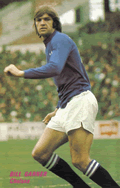 Thanks to everyone who contacted us about the mystery Chelsea strip from 1973-75 with various theories. Nik Yeomans has now found the solution in the club's programme notes from February 1974 where we learn that the change was made because both sides normally wore white socks. (Until the early 70s clashes of this sort were not an issue.) The fashion-conscious management thought wearing all-blue with black socks would look "too dark" so white shorts were worn instead (ignoring the fact that now
Thanks to everyone who contacted us about the mystery Chelsea strip from 1973-75 with various theories. Nik Yeomans has now found the solution in the club's programme notes from February 1974 where we learn that the change was made because both sides normally wore white socks. (Until the early 70s clashes of this sort were not an issue.) The fashion-conscious management thought wearing all-blue with black socks would look "too dark" so white shorts were worn instead (ignoring the fact that now 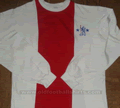 both teams would be in the same shorts). The result was a pleasing reminder of Chelsea's earlier strips and appeared a few times before blue socks were adopted when socks clashed.
both teams would be in the same shorts). The result was a pleasing reminder of Chelsea's earlier strips and appeared a few times before blue socks were adopted when socks clashed.
I have reinstated Chelsea's Ajax-style change strip after Rodney George confirmed that it was worn just once at Manchester City. This is Steve Kember's match shirt from Richard Boulert's 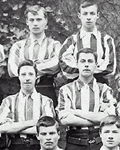 collection (photo courtesy of oldfootballshirts.com).
collection (photo courtesy of oldfootballshirts.com).
Current Season Updates
Port Vale (3rd), Southampton (3rd).
Historical Updates
Coventry City (1993-94 socks corrected): Fulham circa 1894 (photo left). A different version of the old Craven Cottage crest has also been found.
10 January
After a meaningful chat with his mum over Christmas, Vincent Tan has  announced that Cardiff City will revert to playing in blue from today, a decision endorsed by the Football League.
announced that Cardiff City will revert to playing in blue from today, a decision endorsed by the Football League.
Now here is an oddity. On the left is Charlie Cooke playing for Chelsea at Leeds in 1973-74. The team wore the same strip, which resembles their classic 1950s outfit, at Stoke and West Ham in the League and in two league Cup ties against Stoke City in 1974-75. If you know the story behind this unusual variant strip please contact me.
Inverness Caledonian Thistle (2014-15 3rd kit added).
International Updates
Wales 2015 strip added.
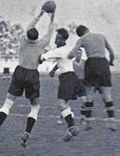 World Cup 1934: Austria socks corrected. The Wunderteam borrowed a set of light blue shirts from SC Napoli for their game with Germany because both sides usually wore white shirts (photo right).
World Cup 1934: Austria socks corrected. The Wunderteam borrowed a set of light blue shirts from SC Napoli for their game with Germany because both sides usually wore white shirts (photo right).
World Cup 1962: Czechoslovakia sleeves corrected v Hungary.
Word Cup 1970: Belgium socks corrected v El Salvador.
World Cup 1974: Detailing added to Argentina, East Germany and Brazil kits in final group stage.
World Cup 1990: Missing manufacturers' logos added to Czechoslovakia, Soviet Union, United States, Costa Rica kits.
World Cup 1994: Logos added to Saudi Arabia shorts.
World Cup 2010: Texture added to Mexico shirts.
My thanks to André Conceição e Silva for the World Cup updates.
8 January
Sadly, Hereford United became the latest former member of the Football League to be wound up in the High Court on 19 December and their record has now been expunged from the Southern League. A summary of recent events has been added to their club section.
International Updates
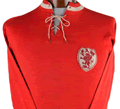 Wales: I've had this photograph of an original Wales shirt from 1914 knocking around for a while: note the interesting crest. It is still unclear when Y Ddraig Goch was adopted by the FA of Wales although we do know that the Prince of Wales' feathers adorned the team shirts in their earliest matches.
Wales: I've had this photograph of an original Wales shirt from 1914 knocking around for a while: note the interesting crest. It is still unclear when Y Ddraig Goch was adopted by the FA of Wales although we do know that the Prince of Wales' feathers adorned the team shirts in their earliest matches.
Scotland: Strip worn against Switzerland in November 1982 added: Euro 96 unused change strip added.
World Cup 1954: England sleeves corrected v Uruguay.
World Cup 1986: Mexico shorts detailing corrected.
World Cup 1990: Spain detailing added to sleeves and shorts: Soviet Union crest corrected on change strip.
World Cup 2010: Mexico sleeves corrected v Uruguay. South Africa shorts trim corrected.
7 January
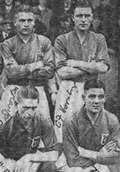 Within hours of posting yesterday's question about the blue/gold halved Leeds United shirt, HFK's elves were at work solving the mystery. Steve Lawrence, Jonathon Auty and Martin Hart identified the player as Bert Sproston who played for Leeds between May 1933 and June 1938, narrowing the possible dates down. Martin then found this team photograph from 1934-35: although the quality is not very good, it is possible
Within hours of posting yesterday's question about the blue/gold halved Leeds United shirt, HFK's elves were at work solving the mystery. Steve Lawrence, Jonathon Auty and Martin Hart identified the player as Bert Sproston who played for Leeds between May 1933 and June 1938, narrowing the possible dates down. Martin then found this team photograph from 1934-35: although the quality is not very good, it is possible 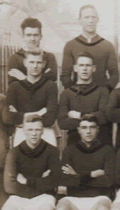 to make out that the gold panel is on the left of the shirt. From the following season until this style was dropped in 1948, blue appeared on the left.
to make out that the gold panel is on the left of the shirt. From the following season until this style was dropped in 1948, blue appeared on the left.
Here is another treasure found by Keith Ellis on eBay, a very rare original photograph of Wolverhampton Wanderers in 1925-26. This confirms the unusual single band worn below the collar that was earlier removed from HFK for lack of corroboration. A more elaborate collar was introduced the following season. Note how dark the jerseys appear: the old gold of the period was almost brown but I believe the film stock in use at the time made them appear much darker than they were in fact. (To bid on this item visit HFK's Wolves page and click on the eBay link there.)
Crest updates: Millwall (2014), Birmingham City (1996-97), Swansea City (1979, 1984), Carlisle United (1969), Yeovil Town (1985), Cambridge United 1974, 1983, Newport County (1948), Everton (1920, 1978, 1982 improved, 1985 added), Brighton & Hove Albion (1983 corrected), Chesterfield (1978), Aldershot Town (2014). Thanks to Joe Finnan, Andrew Scott, Chris Worrall, John Taylor and of course Oleg Baranov for their contributions.
6 January 2015
Happy New Year to all our visitors!
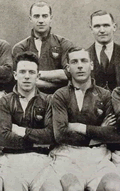 Blackpool 1931-32 now confirmed (left) although we still need details of the socks: Derby County (1973-75 dates
Blackpool 1931-32 now confirmed (left) although we still need details of the socks: Derby County (1973-75 dates 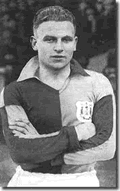 revised): Cardiff City (Aug-Sept 1994 added): Arsenal (1921 change strip added): Leeds United (1938-39 updated). Leeds adopted gold and blue halved shirts in 1934 and wore them until September 1948. All the images I have been able to corroborate have blue panels on the left so the image on the right is a puzzle. If you can confirm the dates and/or player please contact me.
revised): Cardiff City (Aug-Sept 1994 added): Arsenal (1921 change strip added): Leeds United (1938-39 updated). Leeds adopted gold and blue halved shirts in 1934 and wore them until September 1948. All the images I have been able to corroborate have blue panels on the left so the image on the right is a puzzle. If you can confirm the dates and/or player please contact me.
Previous Updates: 2015 | 2014 | 2013 | 2012 | 2011 | 2010 | 2009 | 2008 | 2007 | 2006

